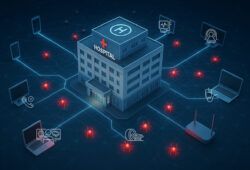The mission to bring interoperability to healthcare
A patient in the ICU is connected to a dozen pieces of life-sustaining medical equipment: IV pumps, a ventilator, monitors, cardiac machines. In the best-case scenario, three of those devices “talk” to one another to respond and adjust to the patient’s situation. But more likely, they work in silos. Meanwhile, that patient’s data is not being collected or managed, so other specialists, and even the patient, cannot access it in the future. Most medical devices and systems can’t share information, creating redundancies, inefficiencies and possible safety risks.

“Each time a patient receives care in the hospital, they must reintroduce themselves,” says Kelly Aldrich, DNP, MS, RN-BC, FHIMSS, Chief Clinical Transformation Officer at The Center for Medical Interoperability (C4MI™). “The data liquidity to help clinicians make the best decisions to impact a positive outcome is simply unavailable.”
C4MI, a nonprofit research lab founded by health systems to simplify and advance data sharing, is working to solve this issue. “We believe that through specifications to drive a common trusted and secure platform infrastructure, we can change the healthcare system’s environment,” says Aldrich.
Guiding principles
A health system might purchase a vital-signs monitor and install it at one hospital, making sure it integrates into the electronic medical record and data warehouse, and the information flows, Aldrich explains. “But if the patient visits another facility, the process of medical device integration and the automation of recording patient information most likely will need technical support and new infrastructure to allow the same monitor to perform like the first, due to a lack of interoperability,” she says. “Nurses and doctors are working at patients’ bedsides to improve outcomes without the technological support.”
Interoperability also aims to solve errors within the patient room by aligning the infrastructure of the technologies clinicians use, so the software can be integrated—allowing devices to exchange information seamlessly. For example, a pain pump delivering pain medication could be connected directly to the computer where the physician enters the prescription, which is also storing information about the patient’s drug allergies. The systems work together to eliminate room for dosage errors and risks to patients.
To meet the high requirements of this mission, technology suppliers must adhere to the following standards:
- High reliability: The technology can operate under complex, high-hazard circumstances for long periods of time without serious error or failure.
- Repeatability: It can be installed and used in an environment using the same method without changing anything and get the same result.
- Scalability: It can adapt and manage an increasing number of users.
Creating change
Interoperability is already making headway. C4MI, representing hospitals and health systems, is collaborating with large technology vendors and policy groups to create certifications and open source technical infrastructure specifications for medical systems and devices. The team has worked with more than 40 industry vendors to create intellectual property agreements and common infrastructure, including Philips, GE, Masimo and InnoVision.
C4MI teamed up with lawmakers on the language for the 21st Century Cures Act, which contains requirements for advancing interoperability and prohibiting developers from preventing or interfering with the access, exchange or use of electronic health information. “There needs to be alignment in meeting the needs of suppliers, in terms of their ability to scale, as well as the needs of health systems, in terms of their ability to use certain medical devices,” says Aldrich.
In June 2021, InnoVision and others such as Philips conformed to the C4MI specifications for medical devices and are building the specifications into their equipment.
“As companies adopt these standards, we will have a common platform where the devices can all talk to each other,” says Aldrich. “This way, hospitals won’t have to pay over and over again to make this happen.”
Getting involved
Clinician involvement in this effort is paramount. “It is critical for clinicians to have a voice and get involved to make sure we are meeting the clinical requirements, which are just as important as the technical security solutions,” says Aldrich.
HealthTrust member hospitals that have contributed to C4MI’s mission include Community Health Systems, HCA Healthcare, LifePoint Health, Robert Wood Johnson Health System, Robert Wood Johnson University Hospital and Scripps Health. However, some members have had to pause their participation with the C4MI to focus on COVID-19 response.
C4MI welcomes all health systems to join its efforts. For more information on becoming a member contact info@center4MI.org.
Share Email EHR, Innovation, interoperability, Patient Experience, Q4 2021




